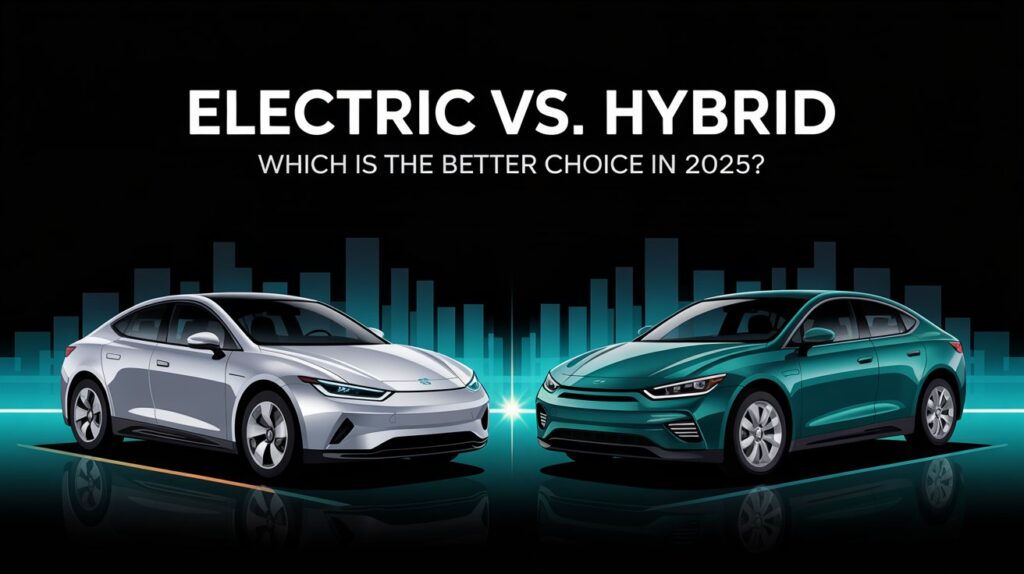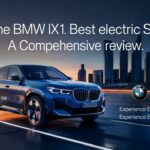Introduction
As the automotive industry accelerates toward a greener future, car buyers in 2025 face a pivotal choice: should they go fully electric or opt for a hybrid? Electric vehicles (EVs) and hybrid electric vehicles (HEVs) are at the forefront of sustainable transportation, offering significant advantages over traditional internal combustion engine (ICE) cars. However, each comes with unique benefits and challenges, making the decision complex. This article explores the differences between EVs and hybrids, their advantages and disadvantages, market trends, top models for 2025, environmental impacts, and practical guidance for choosing the best option based on your needs. By understanding these factors, you can make an informed decision that aligns with your lifestyle, budget, and environmental goals.
Understanding Electric and Hybrid Cars
Electric Cars
Electric cars, or battery electric vehicles (BEVs), are powered exclusively by electricity stored in rechargeable batteries. They lack an internal combustion engine and produce zero tailpipe emissions. Charging can occur at home, work, or public stations, with ultra-fast chargers delivering up to 400 km of range in just 20 minutes (Go-Electra). Modern EVs offer ranges from 200 km to over 600 km, suitable for urban commutes and, increasingly, long-distance travel.
Hybrid Cars
Hybrid cars combine a gasoline-powered internal combustion engine with an electric motor and a battery. They come in two main types:
- Non-rechargeable hybrids (HEVs): These recharge their batteries through regenerative braking and the engine, requiring no external charging.
- Plug-in hybrids (PHEVs): These have larger batteries that can be charged externally, offering 50–80 km of electric-only driving before switching to gasoline.
Hybrids provide a bridge between electric and gasoline power, but their reliance on fossil fuels means they produce emissions when the combustion engine is active. The added weight of dual systems can also impact performance and efficiency, particularly on highways.

Advantages and Disadvantages
Electric Cars
Advantages
- Zero Emissions: EVs produce no tailpipe emissions, making them ideal for low-emission zones and urban environments.
- Lower Operating Costs: Electricity costs are significantly lower than gasoline (approximately €4/100 km vs. €10+/100 km for gas). Maintenance is also cheaper due to fewer moving parts, eliminating needs like oil changes (Go-Electra).
- Superior Driving Experience: EVs deliver instant torque for quick acceleration and operate quietly, enhancing driver comfort.
- Environmental Benefits: When charged with renewable energy, EVs have a minimal carbon footprint, supporting global sustainability goals.
Disadvantages
- Range Anxiety: Despite improving ranges, some drivers worry about running out of charge, especially on long trips.
- Charging Time: Even fast chargers require more time than refueling a gas tank, though ultra-fast options are reducing this gap.
- Higher Initial Cost: EVs often have a higher purchase price, though government incentives can offset this.
- Charging Infrastructure: Availability of charging stations varies, with rural areas often less equipped than urban centers.
Hybrid Cars
Advantages
- Enhanced Fuel Efficiency: Hybrids achieve better mileage than ICE cars, particularly in stop-and-go city driving where the electric motor shines.
- No Range Anxiety: The gasoline engine ensures hybrids can travel long distances without needing a charger.
- Lower Upfront Cost: Hybrids typically cost less than EVs, making them more accessible for budget-conscious buyers.
- Widespread Infrastructure: Hybrids refuel at any gas station, eliminating dependence on charging networks.
Disadvantages
- Emissions: Hybrids produce emissions when using the gasoline engine, reducing their environmental benefits compared to EVs.
- Complex Technology: Dual powertrains increase maintenance costs and potential repair risks due to more components.
- Limited Electric Range: PHEVs offer short electric-only ranges (50–80 km), after which they rely on gasoline.
- Performance Trade-offs: The added weight of batteries and motors can reduce efficiency and handling, especially at high speeds.
Market Trends in 2025
The global shift toward electrification is accelerating, with EVs and hybrids playing critical roles. The International Energy Agency (IEA) reported that 17 million battery electric and plug-in hybrid vehicles were sold globally in 2024, a 20% increase from 2023 (IEA). While specific 2025 projections are unavailable, trends suggest continued growth.

Regional Insights
- United States: Electric car sales rose by 20% in 2024, with one in nine new cars being electric. Plug-in hybrid sales also surged by 50% in Q1 2024, reflecting strong consumer interest in hybrids (IEA).
- Europe: Electric cars accounted for one in four new car sales in 2024, with plug-in hybrids gaining traction in countries like Germany and the UK.
- China: Plug-in hybrids grew faster than battery electrics in Q1 2024, indicating a preference for hybrids in some markets.
- India: Battery electric vehicles (BEVs) are expected to outsell hybrids in 2025, with 113,441 BEVs sold in 2024 compared to 103,252 hybrids. New BEV launches, like the Maruti Suzuki e Vitara, are driving growth (India Today).
Influencing Factors
Government policies significantly shape the market. In India, EVs benefit from a 5% GST rate compared to 28% for hybrids, though some states offer hybrid incentives (India Today). In the U.S., federal tax credits for EVs and PHEVs encourage adoption. Charging infrastructure expansion also boosts EV appeal, while hybrids remain popular in regions with limited chargers.
Top Models for 2025
U.S. News & World Report named Hyundai the top brand for hybrid and electric cars in 2025, with the Hyundai IONIQ 5 and IONIQ 6 winning best electric SUV and best electric car, respectively (U.S. News). Other standout models include:

| Category | Model | Key Features |
|---|---|---|
| Best Hybrid Car | Toyota Camry Hybrid | Excellent fuel efficiency, reliability |
| Best Luxury Hybrid | Lexus NX Hybrid | Premium comfort, advanced features |
| Best Luxury Electric SUV | Rivian R1S | Impressive range, high performance |
| Best Luxury Plug-In Hybrid | Volvo XC60 Plug-In Hybrid | Comfortable, feature-rich |
| Best Plug-In Hybrid | Mazda CX-90 PHEV | Athletic handling, spacious interior |
In India, 2025 will see new BEV launches like the Maruti Suzuki e Vitara and Kia Carens-based EV, while hybrids like the Toyota Urban Cruiser Hyryder and Honda City e:HEV remain popular (India Today).
Environmental Impact
Both EVs and hybrids reduce greenhouse gas emissions compared to ICE cars, but their environmental benefits vary.
- EVs: Produce zero tailpipe emissions and have a lower carbon footprint when charged with renewable energy. However, battery production is energy-intensive, and environmental gains depend on the electricity grid’s cleanliness.
- Hybrids: Emit less than ICE cars but produce emissions when using gasoline. PHEVs can minimize emissions by maximizing electric mode, but their impact depends on driving habits.
Life-cycle assessments suggest EVs have a lower carbon footprint than hybrids, especially as grids become greener. Hybrids, however, are valuable in regions with limited charging infrastructure, offering a transitional step toward sustainability.
Choosing the Right Option
The best choice between an EV and a hybrid depends on your specific circumstances:
- City Driving with Short Commutes: EVs excel due to zero emissions, lower costs, and convenient home charging.
- Frequent Long Trips: Hybrids are ideal, offering gasoline backup for extended range without charging stops.
- Budget Constraints: Hybrids often have lower upfront costs, though EV incentives can narrow the gap.
- Charging Access: EVs are practical with home or workplace chargers; hybrids suit areas with sparse charging networks.
- Environmental Priorities: EVs are greener, especially with renewable energy, but hybrids still reduce emissions compared to ICE cars.
Decision Framework
| Scenario | Best Choice | Reason |
|---|---|---|
| Urban, short commutes | EV | Zero emissions, low costs, easy charging |
| Long-distance travel | Hybrid | No range anxiety, widespread gas stations |
| Limited budget | Hybrid | Lower initial cost |
| No home charging | Hybrid | Relies on gasoline, no charger needed |
| Strong eco-consciousness | EV | Minimal carbon footprint with green energy |
Future Outlook
By 2030, most new cars are expected to be electric or hybrid, driven by stricter emissions regulations and technological advancements. EVs will benefit from longer ranges, faster charging, and lower costs as battery production scales. Innovations like solid-state batteries could further enhance their appeal. Hybrids will evolve with more efficient systems but may shift to niche roles as EV infrastructure expands. Government policies, such as tax credits and charging network investments, will continue to shape consumer choices.
Conclusion
In 2025, both EVs and hybrids offer compelling paths to sustainable driving. EVs provide zero emissions and lower long-term costs but require charging infrastructure. Hybrids deliver flexibility and efficiency without range concerns but fall short on environmental impact. By weighing your driving habits, budget, and access to chargers, you can choose the option that best fits your needs. As the automotive industry evolves, staying informed will help you navigate this dynamic landscape.



